Ominous Beginnings
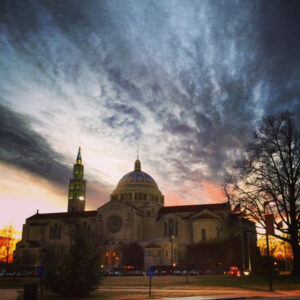
The words in the chapel read “Mary console the children of a land sprinkled with blood and tears.” My trip to the Basilica of the National Shrine of the Immaculate Conception at Catholic University in Washington, DC was one final stop in a half decade quest to obtain justice for victims of child pornography before the United States Supreme Court. The evening light was just falling over the Capitol and the image of suffering children in a land littered with blood and tears seemed an apt description of the victims we were hoping to vindicate–or at least honestly represent–in a case which has achieved worldwide recognition.
Our case is complicated and filled with abstruse legalese, arcane concepts, and uncertain terminology. Most lawyers don’t understand it. I’m sure the public is beyond confused. One mention of the words “proximate cause” and most people’s eyes glaze over. Once we add things like “joint and several,” “contribution,” and “indivisible losses” . . . it’s really more of a legal seminar than a 20 minute argument. It doesn’t make for easy articulation or a media soundbite.
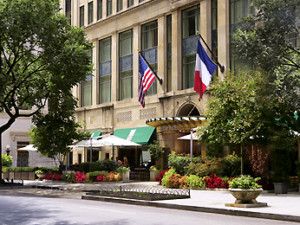
By Monday, which was also Martin Luther King day, the challenges were clear. Unfortunately, the weather was not. We arrived in Washington late Monday afternoon and checked into a cozy French hotel in beautiful 55 degree sunshine. Almost the moment I entered my room, the announcement came that the entire federal government and the courts would close on Tuesday due to an impending snowstorm. Having lived in the Washington area for ten years, I knew what “weather” could do to people unused to snow, ice and even rain. We had 80 people arriving on Tuesday with a carefully planned schedule of a cocktail reception, dinner, lunch, and an historic oral argument where a victim would be represented at the Supreme Court for the first time in history.
Uncertainty became not just a legal obstacle, but a practical one as well. After dozens of calls and emails, texts, chats, Facebook messages, and Tweets, we reassured everyone that yes, the case would proceed, no the Court would not close, and that all of our carefully laid plans would come to fruition. At least that’s what we hoped.
We all joined together with our client for the first time at an incredible Indian feast around the corner from the hotel and waited for the snow to begin. By late Monday night, there was no precipitation in sight and except for the frigid cold, it seemed like the blizzard might not materialize after all. After a 45 minute radio interview which ended near midnight, I was ready for bed in a corner room where I left the blinds open so I could see the arriving storm.
The Arriving Storm
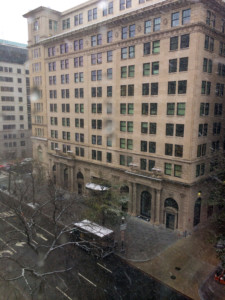
Tuesday morning I awoke to the sound of salt trucks and sidewalk sweepers spreading salt and a iridescent blue brine outside the hotel. After breakfast in my room (the French really do make fabulous croissants—definitely order the Continental breakfast!), Paul and I began a non-stop day. Our first destination was the Supreme Court to attend two oral arguments just to get a feel for the Court and the building. We checked in and figured out the entire somewhat complicated logistics of entering the building and making our way to the lawyer’s lounge.
There was a high profile labor case that morning and the galleries and courtroom was packed with lawyers and lobbyists. After chatting with the guards and Court employees, I soon learned that the Court “never” closes for “any reason” ESPECIALLY when an oral argument is happening. “We will stay the night on cots and blankets if that’s what’s necessary” one resigned security guard implored. “Back during the winter of 1996, when the city was closed repeatedly, the Chief Justice made us stay here and we heard every case, I can’t remember a time when we rescheduled oral argument.”
This was a huge relief for Paul and me and the team we’d assembled, not to mention our client, guests, friends, colleagues and supporters from around the world. We wanted the argument to happen. We were completely ready and to delay or reschedule would have been a disaster and disappointment.
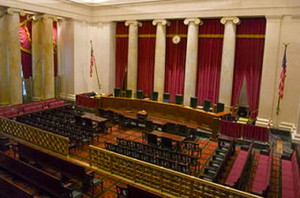
After observing two oral arguments, we felt confident that we were ready for anything the Court could muster. We headed back to the hotel for lunch and a moot “practice” court in the afternoon. By then the snow had begun to fall. It wasn’t a blizzard yet, just some soft flakes and a few windy gusts. The calls and emails, texts, chats, Facebook messages, and Tweets continued non-stop: Yes, the Court would sit tomorrow no matter what, and Yes our cocktail reception would go forward as planned with dinner for those who could make it.
For those coming from the north–New York, New Jersey and Pennslyvania–the situation was getting worse. The bus from New York was running 4 to 5 hours late as the New Jersey Turnpike shut down. Flights out of La Guardia ended at 10 AM, and unfortunately my wife and daughter’s flight was at 11. The blizzard increasing in ferocity and tenor, they struggled to make their way home and gave up when they couldn’t even get a taxi to the Amtrak station 4 miles away. People driving in from Pennsylvania faced huge delays. Our friends and colleagues from Boston simply gave up on the entire endeavor.
By the time our moot court started at 2 PM, the snow was piling up on the sidewalks and streets. The trip to the law firm which was hosting us was a short four block walk, but we struggled through slushy snow and slippery avenues. There were few cars on the roads and even fewer pedestrians. Several participants joined by conference call because a trip in from the suburbs was too treacherous.
A Play about Childhood
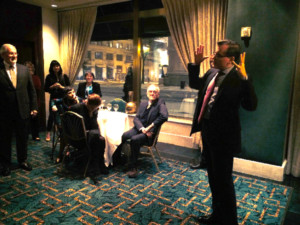
Our final preparations complete, we skated back to the hotel to prepare for the evening’s recognition of our five year quest to the Supreme Court. The event was optional for Paul who earned solitary quietude to reflect on the coming day. I just hoped we’d have enough people to consume the food and drink which was already paid for. I was pleasantly surprised when we filled the elegant lounge with stalwart supporters, weary travelers and frozen admirers. Thankfully many of our guests, the client, and her friends were staying at the hotel which made for a simple short warm trip to the first floor.
The highlight of the evening was the world premiere reading of Molly and Arthur, a play about childhood by Samuel Kahler. Although the selection was short, the actors performed earnestly and everyone was left wondering what mysterious item was in Arthur’s pocket and what would become of the star-crossed lovers who were the unseen subjects of the circumscribed sketch.
After the reception everyone moved to dinner in the ballroom while I headed to the residence of the Dutch Ambassador for a candlelit soiree in honor of the Dutch National Rapporteur on Trafficking in Human Beings and Sexual Violence against Children, Mrs. C.E. Dettmeijer-Vermeulen, who wrote an influential amicus brief and who was attending the oral argument.
Dutch Treat
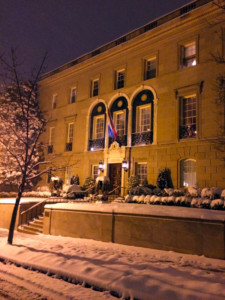
I committed a serious breach of etiquette by arriving 45 minutes late for dinner after bidding farewell to my guests and locating a taxi to negotiate the now seriously snow-covered wintry streets of Northwest, DC. As I arrived at the residence, only the Norwegian and Dutch walkways and entrances were shoveled. Ringing the bell, I was greeted by a hushed waiter who ushered me to the ballroom on the second floor.
The darkened room was lit by candles as soft snow fell outside the ceiling-high windows. The Dutch ambassador was seated in the middle of the table with the Dutch National Rapporteur opposite. I was seated next to her along with Judge Paul J. De Muniz. Next to the ambassador was Professor Warren H. Binford and an official of the Dutch Justice Ministry. Judge De Muniz and Professor Binford authored the Dutch National Rapporteur’s brief along with several students who were also in attendance. The head of the Department of Justice’s Child Exploitation and Obscenity Section was also there representing the United States.
I wish I had saved the menu card (several rounds of wine made me forget). The three course meal was excellent. There was a kale salad and a main course of rice balls, some kind of sausage and root vegetable. Dessert was a rocky road assemblage of crackers and mousse.
I apologized profusely for my lateness and was graciously greeted with “you had a good excuse” before launching into questions and commentary about the case, the Supreme Court, and the expected outcome. It was an amazing evening followed by another challenging trip back to the hotel.
Treacherous Trek
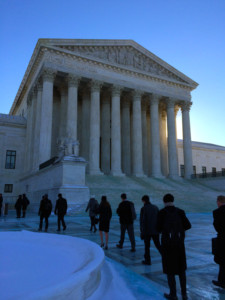
Wednesday dawned bitterly cold and windy with semi-plowed streets negotiated by almost normal traffic. We arranged bus transportation from the hotel to the Supreme Court with the expectation that there might be few if any taxis that morning. After a 20 minute bus ride which ended two blocks from the Court, Paul and I and a small number of followers, braved icy sidewalks and sharp winds for a 9 AM arrival. The tragic members of our entourage who did not have tickets arrived at the Court at 8 AM to stand in the public line in sub-zero temperatures for a coveted seat in the courtroom. Thankfully all of our guests received seats (although a few latecomers were relegated to the three minute seats where they rotated continuously throughout the hour-long oral argument).
After entering the Courthouse, Paul and I, along with Professor Michael Teter and former Acting Solicitor General Neal Katyal, were ushered into the lawyer’s lounge for a briefing by the clerk. Neal was a great addition to our team; all the staff and employees knew and liked him and we were treated like regulars in the lofty elevation of the Supreme Court bar.
The clerks were welcoming and businesslike. We reviewed basic Court etiquette and procedure. We were given our seating assignments and credentials. At 9:40 we were ready to enter the Courtroom. Surprisingly almost the entire Courtroom was filled with almost everyone in dark suits and overcoats. It was difficult to distinguish our friends from our foes but I managed to pick out a few friendly faces in the crowd.
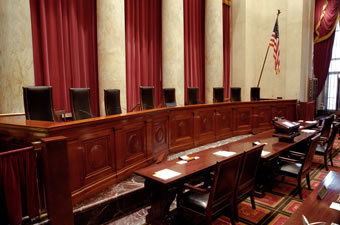
As the respondent, we were given the seats to the right of the lectern. The petitioner was seated on the left and somewhat surprisingly the government sat immediately behind us. I say surprisingly because the government usually occupies our seats and “third parties” sit behind. There were apparently no objections to this arrangement and we all dutifully took our seats and arranged our materials. I sat immediately to Paul’s right with Professor Teter next to me and Neal Katyal (the former Solicitor General) in a rickety seat on the very end of our table. An old hand at the Supreme Court, Neal insisted that his seat was fine and that he could see and hear everything.
After we arrived at the table, Paul noticed a sharply dressed older woman seated in the front row of the marshall’s reserved section. He immediately recognized retired Justice Sandra Day O’Conner who knew him from his time as Justice Burger’s Supreme Court clerk. She apparently found our case interesting and compelling enough to attend the argument which made us realize even further what a unique and unusual case it was.
Representing the United States was the number one career employee at the Solicitor General’s office Deputy Solicitor General Michael Dreeben. Dreeben is an outstanding advocate and only argues three or four of the most important cases each year. He has over 90 oral arguments before the Court and is well-respected by the bench and bar. Also in attendance was the Solicitor General Donald B. Verrilli, Jr., which lent additional weight to an already weighty assemblage.
Order in the Court
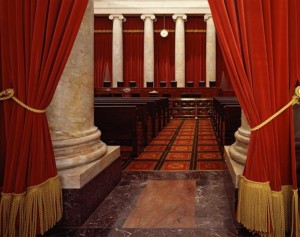
Finally, promptly at 10 AM, the Court was called into session and the justices appeared from behind their velvet curtain. Until you actually visit the Supreme Court, you don’t realize the smallness of the courtroom and the closeness of the bench to the bar; the lawyers arguing the case are literally several feet from the justices with nothing between them except a wooden table and a little air. There is literally no place to hide and nowhere to run. Once you’re seated at the table and the justices are in place, you dare not sneeze, look askance or wince; every hair must be in place.
The argument is always begun by the petitioner, in this case the defendant Paroline’s attorney. Each side in our case received 20 minutes and the petitioner is allowed to reserve some of his time for rebuttal.
Paroline’s attorney started by arguing mostly the facts. It was a decent if somewhat disjointed argument stressing their position that there was no proof that Paroline caused any injury. Even if there was harm—and the court and every court has found that Amy was “harmed”—the victim Amy could not show with any particularity that Paroline caused any injury. And even if Amy could show injury, she could not show how much injury, and that any restitution should be based on a specific showing of how much, in dollars, Paroline’s injury caused.
Paroline’s argument was met with mostly silence from the Court. Sometimes this is good because it means you are winning. Sometimes it’s bad because the Court just wants to move on. In this case it was bad. I remember a few questions from the justices mostly on specifics, a few on legal questions. There were several confused answers by Paroline, but no real bombshells. I kept waiting for the justices to hone in on a certain issue but when nothing materialized I was left with very little sense of how any of the justices were seeing the case.
One of my goals during the oral argument was to determine how the Court was viewing the case; what were the strengths, weaknesses, and which justices were for us, against us, or somewhere in the middle. I really did not get any sense from Paroline’s argument exactly where the Court was on our case.
Then suddenly and quite abruptly, Paroline’s lawyer reserved the remainder of his time and sat down. I was surprised by this. It only seemed that about half his 20 minutes had passed. The five minute light on the lectern was not lit. It really felt like he had just started his oral argument and then poof it was over.
Fudge Factor
The next side to argue was the government led by the very capable Michael Dreeben who, dressed in the Solicitor General’s standard issue gray wool morning coat, looked somewhat like the undertaker in the musical Oliver. Dreeben was calm, succinct, and direct in his argument. The Court immediately had questions. The interchange was robust and spirited with no clear sense of where the Court was headed. There were questions about cause-in-fact and injury. Scalia mumbled about due process concerns. Kagan was focused on indivisible injury. Surprisingly there were very few questions about proximate cause which initially and throughout the district courts and courts of appeal was the biggest legal stumbling block.
Of greatest concern was that there was no justice who was clearly on our side. There is often a justice who will pull punches with the other justices and fight for one position or the other. I sensed a lot of consternation on the Court. They were all grasping at concepts and legal theories with a clear understanding of the harm to victims, but with little sense of how to properly and fairly compensate them.

Veganbakingnet CC BY SA
One thing which was immediately evident was that the Court was clearly thoroughly familiar with all the issues in the case; the facts, the legal arguments, alternative theories, problems, possibilities and amicus briefs. Chief Judge Roberts honed in on serious problems with the government’s arguments expressing skepticism about what happens in the first case under their so-called “multi-factor test” or when it’s difficult if not impossible to predict how many defendants will be convicted or ordered to pay restitution in the future.
The government was left adrift on this point when Dreeben made his one rare mistake by invoking a “fudge factor” as an integral part of the government’s proposed “multi-factor test.” “Fudge factor?” either Scalia or Chief Justice Roberts scolded. How can the Court fashion a principled decision which incorporates a fudge factor? Soon thereafter Dreeben sat down and I heard a whisper behind me cautioning, “fudge factor? you shouldn’t have said that.”
“Fudge factor” is probably the best way of describing the government’s entire problematic position and might just be their undoing in this case.
A Victim’s Advocate Eating Fudge
Finally it was Paul’s turn to argue. He was right on it pinch hitting his carefully prepared opening by blasting the government’s fudge factor formula. Not surprisingly you not only need to defeat your opponents, you need to win the Court. We had the difficult argument.
The Court was clearly concerned about the fairness issue; how and why should one defendant with two images of Amy be saddled with her entire losses? Time and again Paul kept coming back to the indivisible nature of the harm as justice after justice spun this issue. Time and again Paul was met with blank stares by the justices, skepticism, and consternation. A few times he was met with tacit acknowledgement although there were no solid endorsements of our key theory either.
It was Chief Justice Roberts who finally began questioning the proximate cause aspect of our case. It really seemed like he was not thoroughly conversant with our arguments and the statutory construction. Other justices wanted to move on from this issue. Justice Sotomayor told Paul to “forget about proximate cause, let’s say you won on that issue . . .” It was the first sign that one of the justices was on our side and was urging us to help her convince the other justices of the merits of our case.
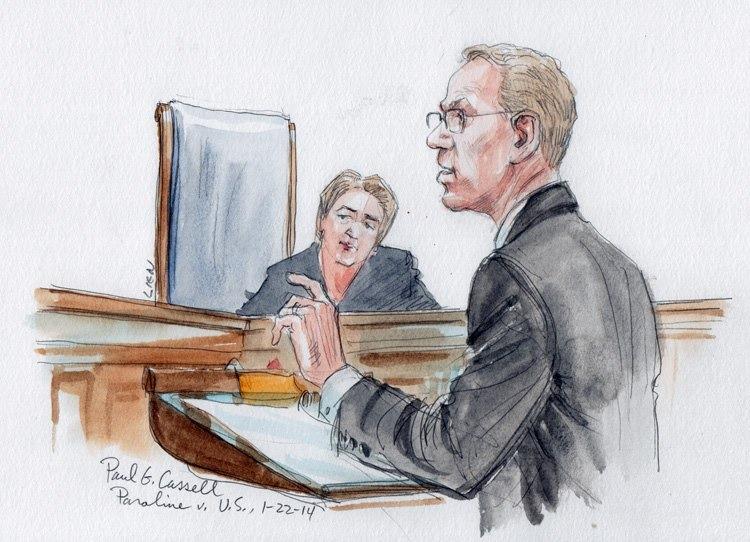
Meanwhile Justice Kagan was the most skeptical and pointed of all, Justice Scalia didn’t seem to buy our well-crafted statutory plain language arguments (several citing his book), and Justice Breyer wanted to turn the whole messy affair over to the United States Sentencing Commission which he helped create and where—presumably unbeknownst to him—Paul and I sit on the Victim Advisory Group.
My distinct sense of the Court is that they were seriously grappling with numerous difficult troubling legal concepts and issues and I’m sure more than a few of them wondered which four justices agreed to take the case. There was no center, no real supporters of any position, lots of skepticism on all sides, and all the justices expressed concern for the victims with lots of consternation on how to arrive at a fair outcome.
Paul did an amazing job advancing our cause, defining our arguments, and engaging the justices at the highest level. He wasn’t afraid to correct misstatements or assert a point which was rhetorically twisted in legal cat and mouse gamesmanship. It was a good day for victims; the first day a victim was fully and independently represented before the United States Supreme Court. It was a masterful presentation with 50 questions in 20 minutes. Paul answered them all and then some.
(Paul also sent me his outline right before he boarded the plane to fly to Washington. Just in case…thankfully I didn’t need it!)
After the victim presented her case, Paroline still had his rebuttal time which I estimated to be between 6 to 10 minutes. When his lawyer stood up to once again address the Court, the Chief Justice (who is the keeper of the time), granted him “5 minutes” to make his final plea. I was a little surprised by this, but Paroline’s lawyer didn’t wince. He launched into another rambling explanation of how the “full amount” required by the statute wasn’t really the “full amount” but some lesser amount somehow connected to the defendant’s “contribution” to the losses.
Once again the justices were largely silent. A few polite but pointed questions later and the case was finished. The Court deemed the case submitted and everyone jumped to their feet to clear the courtroom and the lawyer’s tables. There was a hurried exit from the courtroom as the next set of lawyers prepared for center stage.
Endnote
After the next argument was completed, the justices arose from their seats and disappeared behind the floor to ceiling velvet curtain to caucus in their private anteroom where they voted on our case. The senior justice in the majority decided who will write the decision. The senior justice in the minority decided who will write the dissent.
Given the obvious lack of consensus on the bench, I cannot imagine voting, just one hour later, on how our case will turn out. Oral argument is the end of the Court’s consideration of a case, not the beginning. And once the justices vote, they rarely change sides.
Each decision is drafted and then distributed to all the justices for input, with special consideration by the dissent which distributes its own decision, which is then digested and responded to, until all the sides—the majority decision, concurrences, dissents—are carefully parsed and responded to, incorporated and dissembled, by each justice, until final versions of the decisions are ready for public release. The timing of the announcements of decisions is governed not by the importance of the case, but by the drafting and re-drafting process which, in a complicated case like ours, can take many months.
In other words, we don’t expect a decision until late April at the earliest with a likely release in June, sometime before the Court’s session ends on June 30th.
Aftermath
We left the courtroom and headed to the lawyer’s lounge for our coats and cell phones. It remained a bitterly cold day with temperatures in the teens and a windchill at or below zero. It was a dry frosty cold which stung my fingertips and pierced my Austrian loden wool jacket.
For some odd reason perhaps due to his Western heritage or mountain longings, Paul removed his coat and scarf and presided like a lighthearted lawyer on a spring day. Then his entire family removed their coats and scarves and posed in what appear to be the gentlest images in the mildest weather. In reality it was like a freezer. Crazy.
A brilliant sun pierced the icy air as we posed for pictures on the marble courthouse steps. Nearby pro-life demonstrators were chanting in condemnation of the Roe v. Wade decision which was issued on this day in 1973. Several reporters shivered in the distance and beckoned us to come over for a statement and interviews. Given the weather we felt guilty not obliging.
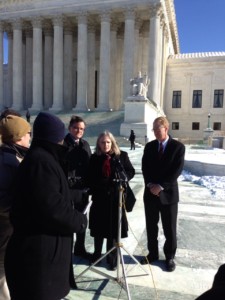
We answered the reporters through clenched teeth, our frozen lips barely mouthing the words. Eloquence escaped me as my nose and cheeks began to harden and icy tears appeared in my eyes. I struggled to retrieve my carefully honed soundbites while the wind swept my words away like snowflakes. The reporters were buried under scarves and facemasks, their teeth chattering and their pens scratching on their starchy frozen notepads. Why was it so cold??!! This is (almost) the South for god sake. The news conference had to end because no one wanted to stay outside another minute.
Finally it was off to a nearby luncheon which was attended by 60 people and hosted in Paul’s honor. When Paul entered the room—appearing neither frozen or flushed—he was greeted with a standing ovation. Win or loose, clearly Paul had stolen the show that day and presented our case in the best way possible.
The crowd of amici brief writers, our clients, fellow victim advocates, colleagues, friends and family, asked questions and provided their assessments at an impromptu debriefing. Everyone felt the justices treated the victims and the issue with respect and compassion. No one felt there was any consensus on the Court or sense of direction. No one was willing to make any predictions beyond it being a big win for victims and an unprecedented attention to the issue of child pornography victimization and exploitation. In summary, it was a great day for the issue, for crime victim’s rights, and exploited children.
The End of an Historic Event
The long day wasn’t over until we heard the Dutch National Rapportuer speak at Georgetown Law School about our case and the Dutch response to child sex abuse and online exploitatiion. She gave an excellent and informative presentation based on her groundbreaking 2011 report on child pornography. On Thursday, our final day in Washington, the Dutch National Rapporteur led a Congressional briefing sponsored by the National Center for Victims of Crime, the National Crime Victim Law Institute and the Netherlands Embassy in Washington, DC, in coordination with the Congressional Victims’ Rights Caucus.
Now the waiting begins. We are all back in our offices, back to work, a bit stunned and amazed at what just occurred. Life before the Supreme Court was filled with endless preparation, thousands of details, writing and rewriting talking points, tweaking arguments, anticipating questions, strategizing, checking one last case one last time. The twenty minutes came and went—a moment in time—with ten thousand hours before and a distant horizon ahead.
My prediction is that there will be at least four written decisions with several concurrences in support and a dissent with at least one concurrence. Maybe that’s five decisions. I don’t think it will be 9-0 in favor or opposed (in favor of what? opposed to whom?). Regardless of the outcome, it will be a watershed decision in an unprecedented evolving area of the law. For Paul and me, it’s the culmination of many years of hard work and dedication to a cause which is still emerging. We both plan on being around for many more years to see this one through to its ultimate conclusion!
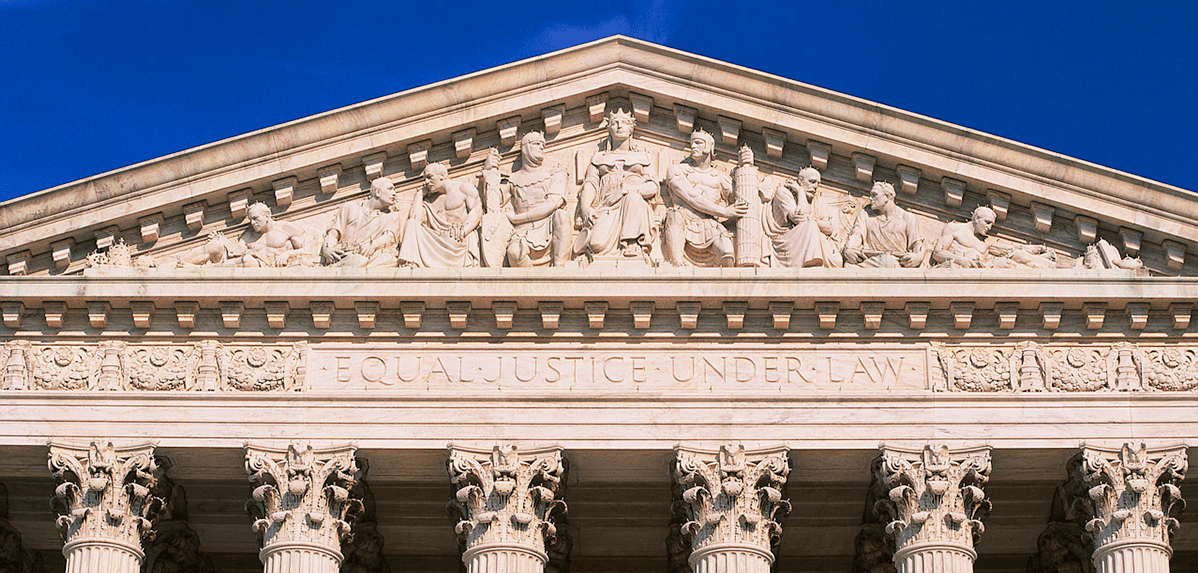
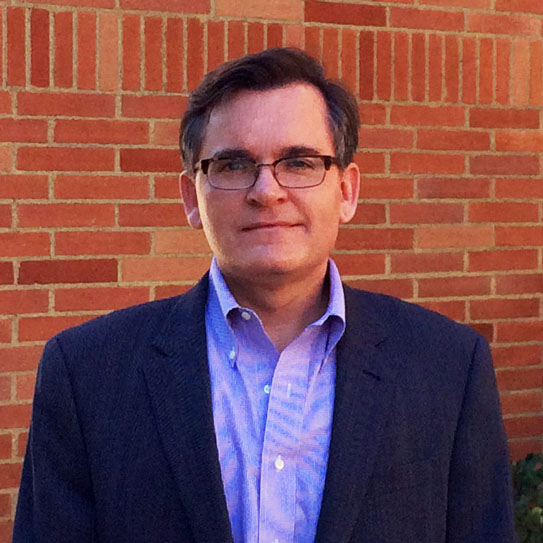
Leave a Reply